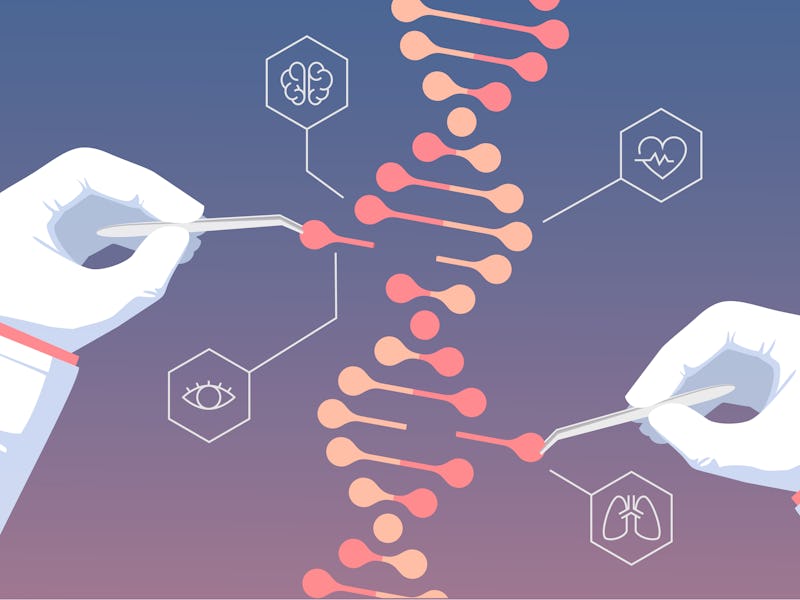CRISPR is using urine to treat this extremely common disease
Who knew peeing in a cup had so many advantages?

CRISPR is the poster child for gene editing, but its use as a medical tool doesn't stop there. Researchers have now used this technology to design at-home tests for kidney transplant infections that let patients monitor their health through a simple smartphone app. The innovation could have huge implications for how scientists deal with weakened immune systems.
In the U.S., chronic kidney disease affects an estimated 37 million people and is the ninth leading cause of death. Treatment options for this disease are largely limited to invasive procedures like dialysis or kidney transplants, but even then patients are still at risk of transplant rejection or infection. To improve early detection of these kinds of negative outcomes, a team of international researchers has developed a diagnostic assay, or test, using CRISPR to easily detect early signs of infection using only a patient's urine.
This CRISPR test would be cheaper than options currently available at doctors' offices and could in the future be done from the comfort of the patient's own home.
"Most people think of gene editing when they think of CRISPR, but this tool has great potential for other applications"
Michael Kaminski, the lead author of the study and head of the Kidney Cell Engineering and CRISPR Diagnostics Lab at the Max Delbrück Center for Molecular Medicine, said in a statement that while people typically associate CRISPR (short for clustered regularly interspaced short palindromic repeats, a family of DNA sequences that can be cleaved with proteins) with gene editing, the tool is actually more widely applicable.
"Most people think of gene editing when they think of CRISPR, but this tool has great potential for other applications, especially cheaper and faster diagnostics," said Kaminski.
In a study published Monday in the journal Nature Biomedical Engineering, the researchers designed a test using CRISPR that takes advantage of one very common medical diagnostic: peeing in a cup. Measuring biomarkers in urine is already a common practice for at-home pregnancy tests and for some diabetes tests, but the authors write that it has yet been developed for at-home kidney disease monitoring in the same way.
When developing their test, the authors focused on two common "opportunistic" viruses that attack transplant patients called cytomegalovirus (CMV) and BK polyomavirus (BKV) as well as a biomarker called CXCL9 mRNA, which spikes during acute transplant rejection.
This CRISPR assay works by isolating virus DNA in urine and using Cas proteins to cut the target sequence.
Using an optimized CRISPR protocol called SHERLOCK (high-sensitivity enzymatic reporter unlocking) the test works by locating the target DNA of these viruses and making enough copies so that CRISPR can detect it in concentrations as little as one molecule. Then, similar to an at-home pregnancy test, a test strip is dipped into the urine sample to test whether or not signs of those viruses were detected.
"The challenge is getting down to concentrations that are clinically meaningful," said Kaminski. "It really makes a huge difference if you are aiming for a ton of synthetic target in your test tube, versus if you want to get to the single molecule level in a patient fluid."
After applying their test to over 100 clinical specimens (samples of urine) the researcher reported high diagnostic accuracy, with 100 percent accuracy identifying the viruses in urine and 93 percent accuracy identifying the kidney rejection biomarker.
Also similar to an at-home pregnancy test, the authors write that distinguishing between a positive and a negative result -- one line or two lines -- can be challenging. To make this easier for patients, they also developed a smartphone app that uses your phone's camera to evaluate the result of the test strip and make a definitive positive or negative call. The authors write that the whole process, starting at isolating the virus and ending at the smartphone's evaluation, takes less than two hours.
More than just a new way to use CRISPR, researchers stress that personalized and repeated diagnostics like this are an essential weapon in the fight against kidney disease. They hope that future research in this area can continue to explore how cost-effective approaches like this can improve the lives of millions of Americans, and people around the world, suffering from this illness.
Abstract: In organ transplantation, infection and rejection are major causes of graft loss. They are linked by the net state of immunosuppression. To diagnose and treat these conditions earlier, and to improve long-term patient outcomes, refined strategies for the monitoring of patients after graft transplantation are needed. Here, we show that a fast and inexpensive assay based on CRISPR–Cas13 accurately detects BK polyomavirus DNA and cytomegalovirus DNA from patient-derived blood and urine samples, as well as CXCL9 messenger RNA (a marker of graft rejection) at elevated levels in urine samples from patients experiencing acute kidney transplant rejection. The assay, which we adapted for lateral-flow readout, enables—via simple visualization—the post-transplantation monitoring of common opportunistic viral infections and of graft rejection, and should facilitate point-of-care post-transplantation monitoring.